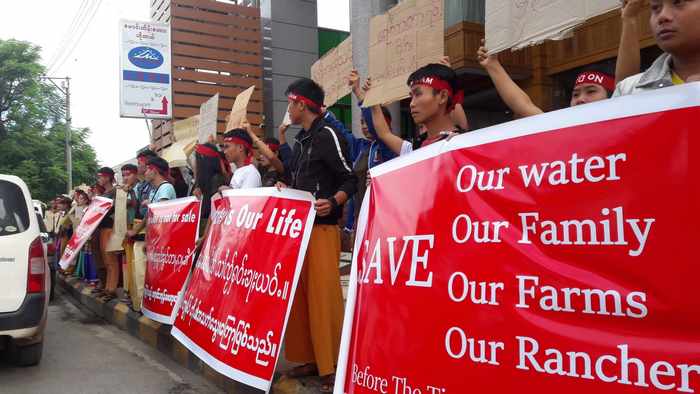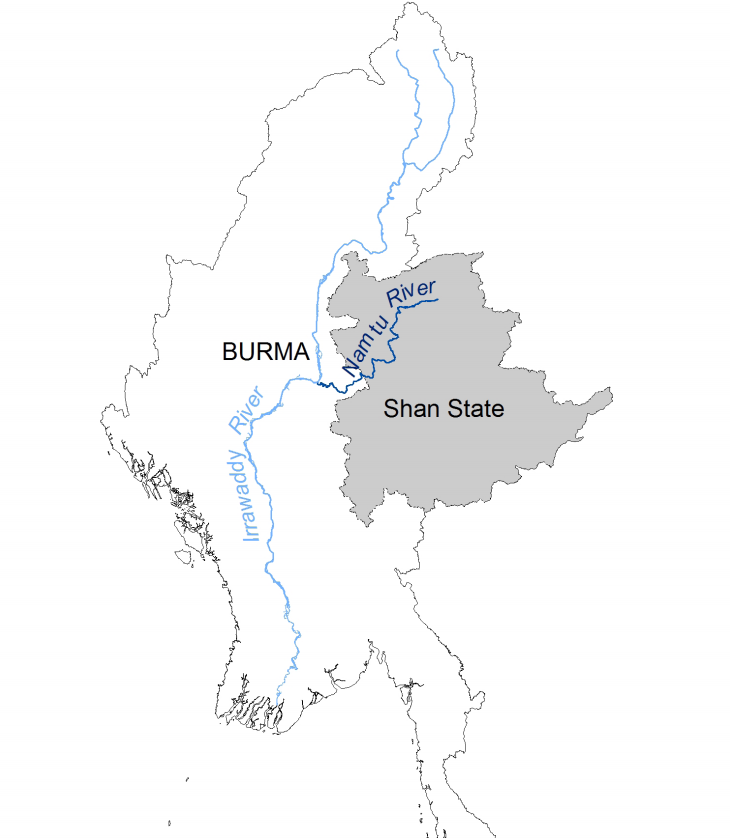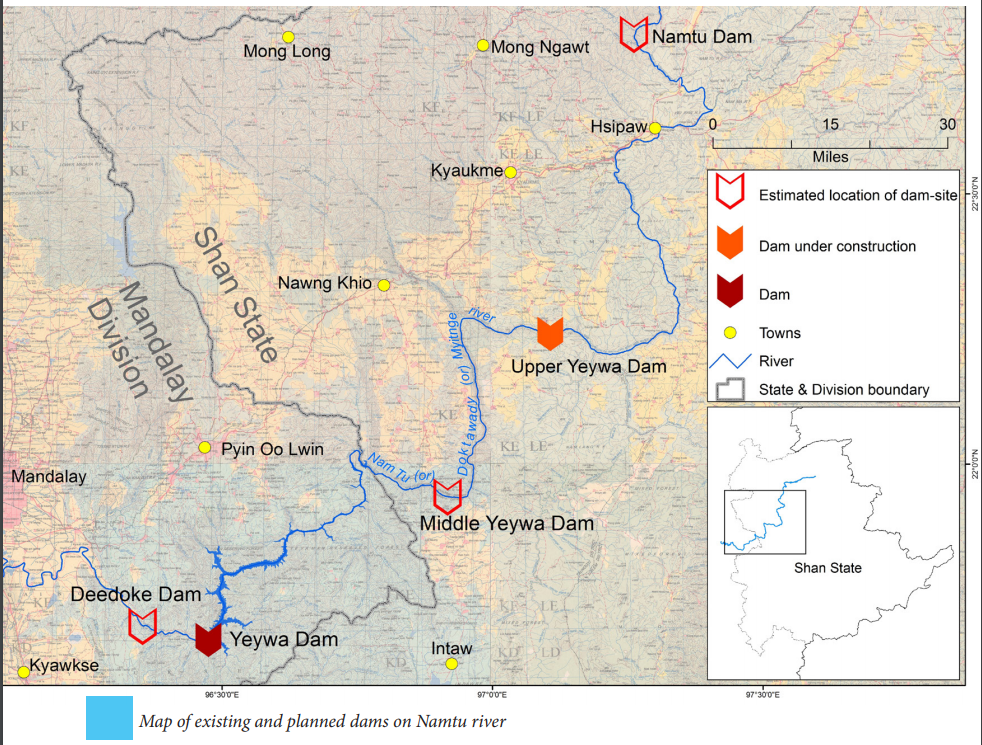On September 12, some 200 Shan Civil Society Organizations’ (CSOs) members staged a protest rally in Taunggyi, capital of the Shan State, while the International Financial Corporation (IFC) met at Mountain Star Hotel for the “Cumulative Impact Assessment of the Namtu/Myintnge River and its Management.”

Of the five dams planned, three hydro-power dams have already been built on the Namtu River in Mandalay Region, and two more are under construction in northern Shan State: the Upper Yeywa—or Ta Long—in Kyaukme Township and the Mo Tein—or Lee Lu—in Hsipaw.
“We protested against the IFC because the IFC is one of the investors in the construction of hydro-power projects,” Myo Min Latt, leader of the former Nam Khong Student Organization, told Shan Herald Agency for News (SHAN). “Regarding dam construction, we even oppose the World Bank, because it has given loans for dam construction. IFC is one of the partners in the dam construction.”
Protesters were locals from Ta Long, Hsipaw, Laikha, Mongnai, Maukmai, including CSOs from the Nam Khong Student Congress, the Salween Brotherhood, the Mong Pan Youth Association, and the Shan State Peace Task Force.

Even before the IFC meeting in Taunggyi they have sent in their opposition, saying that the IFC was not taking into account the situation on the ground concerning the Namtu River dam-building and the locals’ rejection of the investment in hydro-power on the foreseeable negative impact on communities.
“The area is still unstable and there are often clashes. I think it’s an unfair situation,” Win Htel Kaung Myat of the Shan State Peace Task Force said. “The political situation is still fragile. They are not considering the sensitive political situation in Shan State.”
Recently, in August more than 5,000 internally displaced persons who have fled their homes, where the dams are proposed, due to the armed conflict between the Burma Army and the Northern Alliance ethnic armed groups which intensified after August 15 and is still ongoing.
In Kyaukme Township of Upper Yeywa Dam and Hsipaw Township Mo Tein Dam pagodas, monasteries, villages, paddy fields, orchards and other historical sites will be submerged if the dams are completed.

Ta Long, made up of two villages in Kyaukme Township, have around 1000 inhabitants are engaged in farming, where each individual owns two acres of organic orange and pomelos plantations grown along the riverbank, which are famous within the region. They earned around 2 million kyat (US$1,300) annually for each household and this livelihood would be lost if the Upper Yeywa Dam is completed.
The Shan State Rivers Watch echoed the same alarm as the locals, which they have time and again made their angst known to the authorities and stakeholders but so far all have fallen on deaf ears.
“An Environment and Social Impact Assessment (ESIA) was carried out for the dam only in 2014, six years after the dam project had begun. During the ESIA, the villagers stated clearly that they were not willing to move. Despite this, dam-building has continued, with funding from China, and with the involvement of Chinese, Japanese, German and Swiss companies,” wrote the Shan Human Rights Foundation (SHRF) in its report “Save the Namtu River” in March 2016.
According to the report, the villagers only became aware that the dam would be built when preparation for construction began at the dam site in 2008, during the State Peace and Development Council (SPDC) military rule.
It is a clear violation of the people’s right if it is looked upon according to the World Commission of Dam, which wrote: No dam should be built without the “demonstrable acceptance” of the affected people, and without the free, prior and informed consent of affected indigenous and tribal peoples.
On July 7, 2014, the Ta Long villagers were summoned to the Kyaukme Township administrative hall to attend a meeting held by representatives of the Ministry of Electric Power and consultants of Resource and Environment Myanmar Co. Ltd, who had been hired to carry out the Environmental and Social Impact Assessment (ESIA) for the dam.
At the meeting, recorded on video by the consultants, several villagers said clearly that they refused to move. The village headman, Loong Aw Sein Da, was filmed saying: “ If you come to survey our village, and tell us we must move and offer us compensation, we won’t be able to accept this. We have been living here since our ancestors’ time. We are rural people. However much money you pay us, it has no meaning for us. We rely on our crops – our corn and soybean plantations, our orange and pomelo orchards. The oranges and pomelos from Ta Long are famous throughout Kyaukme and Hsipaw. We rely on growing these crops. We don’t know any other livelihood…We refuse to move.”

The irony is that the Namtu River dam-building project was thrust down the throat of the locals by the then military regime, but it now seems even with the civilian-headed government of National League for Democracy (NLD) in place, the local people’s opinion have been ignored or forcefully pushed through at the expense of their livelihood.
The powers-that-be in Naypyitaw should at least honour the Nationwide Ceasefire Agreement (NCA), which it is also a signatory together with eight Ethnic Armed Organizations (EAOs) in October 2015, and wait it out until political settlement is achieved and the establishment of federal union in sight, to decide upon sensitive and mega developmental projects in ethnic states with the participation of the locals, if not for anything else.
Besides, the NLD should also be aware of the NCA Chapter 9, Protection of Civilians, which has 17 points, includes: to provide necessary support in coordination with each other to improve livelihoods, health, education, and regional development for the people; to avoid forcible confiscation and transfer of land from local populations; to avoid the destruction or actions that would lead to the destruction of schools, hospitals, clinics, religious buildings and their premises; and to ensure the security and development of civilians living in ceasefire areas.
Time for the NLD to break the silence and side with the affected people.



